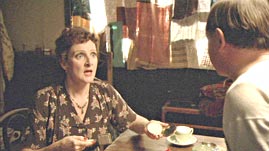Teachers' Domain - Digital Media for the Classroom and Professional Development
User: Preview

Source: Darlow Smithson Productions "The Diary of Anne Frank"
Watch a dramatization of moments in the life of Anne Frank, a young Jewish girl who lived in hiding from the Nazis during World War II with her family and four other people. The alternating boredom and terror of life in hiding, as well as Anne’s growing desire to become a serious writer, are captured in this video segment and the two supplemental video segments below, all adapted from “The Diary of Anne Frank” and based on entries from Anne's diary.
The Scare (Video)
I Want to Be a Writer (Video)
In May 1940, Nazi Germany invaded the Netherlands. “Jewish laws” were put in place, starting with a few restrictions and eventually banning Jewish people from every aspect of Dutch public life. Jewish people could not shop in Gentile stores and could only shop in Jewish stores on certain days at certain times. They could not ride on buses or in taxis, own a car, leave their homes between 8 PM and 6 AM, sit on park benches, or go to the movies. Jewish people also could not own businesses, so Anne’s father, Otto Frank, signed over control of his two companies to his employee and friend, Johannes Kleiman.
After segregating Jewish people from their fellow Dutch neighbors, the Nazis began rounding them up for transport to concentration camps in other countries. In July 1942, Margot Frank, Anne’s elder sister, received her notice to report for transport to a work camp. Otto Frank was prepared for this moment: months earlier, he had asked his secretary, Miep Gies, if she would help hide his family in the upper story of one of his office buildings. She agreed, and on July 6, 1942, the Franks left their home and began their life in hiding. For just over two years, with the help of Kleiman, Miep and her husband Jan Gies, and two more of Otto Frank’s employees, Bep Voskuijl and Victor Kugler, the Franks lived with four other people in the “Secret Annex.”
This was the most practical decision possible considering the lateness of the date. By 1942, all hope of escaping from Holland had long since faded. Ironically, the Franks had originally emigrated to Holland in 1933 to escape the anti-Jewish laws in their native Germany. Holland was seen as a tolerant, free society where they, as Jews, would be safe. Once Holland fell, the German government and occupation forces assured the Dutch people that they were fellow “Aryans” and that Germany had no intention of interfering in Dutch government or daily lives. The occupying Nazi forces moved relatively slowly to segregate and remove the Jewish population, both native Dutch and immigrant. They did not immediately arrest Jewish people and humiliate them publicly, as they had done in other countries, particularly Austria. No synagogues were burned. As a consequence, very few Dutch Jews, or Jewish immigrants, like the Franks, attempted to escape from Holland after the invasion.
The Franks were not unique in their experience of living in hiding. Once it became clear that all Jewish people, regardless of their citizenship, were going to be singled out and rounded up for deportation, many Jews went into hiding with their Christian neighbors. The Dutch underground also participated, hiding thousands of Jewish people and moving them from safe house to safe house.
On August 4, 1944, the Franks were discovered and arrested. The identity of the person who informed the authorities of their hiding place is still unconfirmed. The Franks were deported to Auschwitz; Anne and her sister Margot were eventually sent to Bergen-Belsen, where they died some time in March 1945, one month before the camp’s liberation by Allied soldiers. Otto Frank was the only survivor of the group from the Secret Annex.
 Loading Standards
Loading Standards